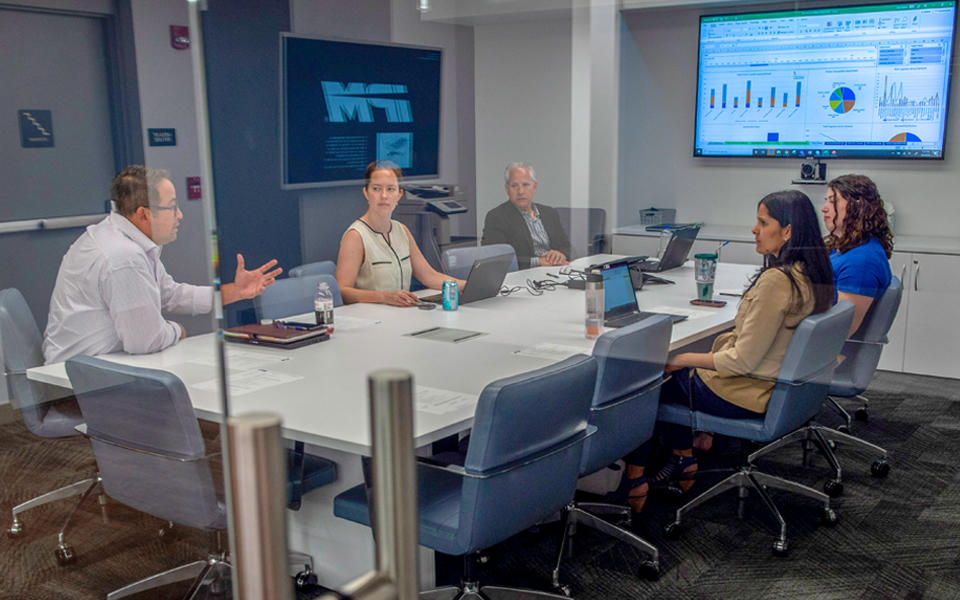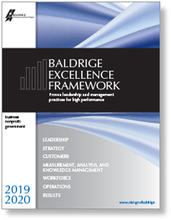Blogrige
The Official Baldrige Blog

It's easy to love a well-run small business! Who doesn't admire seeing even the smallest mom-and-pop-run enterprise in your community demonstrating and fostering entrepreneurialism, innovation, and other essential aspects of the American ethos? Who doesn't feel moved by the unique and important role small businesses often play in supporting the local economy and community life?
One example of such a small business is Integrated Project Management Company (IPM)—an Illinois-based small business that earned the Baldrige Award in 2018 for its outstanding practices in all seven areas of the Baldrige Criteria for Performance Excellence (leadership, strategy, customers, performance measurement/analysis/improvement and information/knowledge management, workforce, operations, and results).
Founded in 1988 as the first project management consulting firm in the nation, IPM has expanded its focus over the years beyond manufacturing-related projects to offer specialized services in ten areas of organizational management for clients in the fields of life sciences and health care as well as consumer and industrial products. Demonstrating a commitment to the vitality of local communities, IPM has a philanthropic arm called Project Mercy that provides financial and volunteer assistance to support children, veterans, education, disease research, and homeless people in the areas where the company’s employees work and live.
I recently asked Larry Meyer, managing director of knowledge and process management at IPM, to share how the company has benefited—in good times and bad—from its use of the Baldrige Criteria for Performance Excellence as a leadership and management framework.
“For more than 30 years, we’ve been helping companies accomplish their most complex and critical initiatives,” said Meyer. “We applied the same best practices and principles on our Baldrige journey—and we continue to apply them now.”
The Q&A below capture the rest of the conversation with Meyer.
What are some challenges IPM is facing today and how do Baldrige-based practices help you address them?
At this time, our first challenge is making sure that our IPM family is healthy and safe, including that they are well-informed and can continue to work effectively. Like many businesses, we’ve had clients shift their priorities. Some are delaying engagements, but others are counting on us to help them execute their most important initiatives, especially if those initiatives have changed, whether that be temporarily or permanently.
Our continuous-improvement efforts over the past few years, framed by our Baldrige journey, have helped position IPM for the recent disruption. For example, IT security enhancements enable our consultants to protect client information and communications from their homes. Our internal feedback loops— thanks to an OFI [opportunity for improvement] uncovered in the [Baldrige Award] application process—have helped the executive team make decisions with the most current information from the staff.
We know that if we focus on our core competencies, applying best practices and continuous improvement, we’ll come out of this current situation even stronger.
What are some examples of IPM’s best practices and how they’ve benefited your management consulting business?
IPM benefited from applying our Strategy Realization Model—our process for developing strategic imperatives, ensuring that they’re aligned to our mission and vision, and then executing on the programs and projects that support those imperatives—to our Baldrige journey. Along the way, [Baldrige Award] application feedback then helped us improve our model.
It is important to run the Baldrige journey as a program, or a group of related projects. We established a Program Management Office and a detailed phased approach, including a dedicated manager and focused core team, project charters and schedules, and a change management and communication plan. For example, OFIs were addressed as projects, and they were prioritized against each other and against daily responsibilities.
One of our lessons learned was that we needed to better define our KPIs [key performance indicators]. We measure a lot of things, and it’s important to do so. But we had to evaluate which metrics truly drive performance.
As we’ve embraced the Baldrige Criteria for Performance Excellence in the way we work and think about the business, we continue to look for gaps and OFIs and then apply strong project management processes to address them.
What are your top tips for introducing or sustaining use of the Baldrige Excellence Framework (including the Criteria for Performance Excellence) to promote a small business’s success?
- Make it a big deal. We rang a bell each time we identified an improvement. Then we brought those bells to the Baldrige Award ceremony as our noise makers. To keep the core team and the whole organization engaged, we created branding for communications that showed a school bus and stated, “Get on the bus!”
- Continue to challenge the organization. The application process itself was not easy, but some of the things we learned have helped our business. For instance, we had to find sources of competitive data; not only do we continue to rate ourselves using those benchmarks, but we also continue to seek new competitive data. Our discipline around maintaining records has improved, and online dashboards have improved data access.
- Most important, embrace ADLI [the Baldrige evaluation factors of Approach-Deployment-Learning-Integration] as a framework for assessing processes across the organization. Use of the ADLI framework has improved our ability to be self-critical of our processes and continues to be a great mindset for us to apply as we go forward on our Baldrige journey.
What do you view as key reasons or ways that organizations of your size or sector can benefit from using the Baldrige framework?
IPM’s primary reason for embarking on the journey was to improve our performance, competitiveness, and sustainability. To us, the benefits of the Baldrige framework are clear: It will enable sustained growth, competitiveness, and differentiation by validating our high performance, giving visibility into areas that we need to improve, and providing an enhanced measurement framework.
Any organizations that want to continuously improve their processes would benefit from a framework that evaluates every critical element of a business. For small or immature companies, it is an excellent process for establishing a model and practices that will support strategy development. It will help organizations remove the obstacles to growth, profitability, differentiation, quality, and more. For more mature companies, it provides a means to accelerate growth and competitiveness.
To us, the benefits of the Baldrige framework are clear: It will enable sustained growth, competitiveness, and differentiation by validating our high performance, giving visibility into areas that we need to improve, and providing an enhanced measurement framework.
What is your “elevator pitch” about the Baldrige framework and/or assessment approach? In other words, what would you say to a group of senior leaders of a business who are not familiar with the Baldrige framework if you had 1-2 minutes to tell them something about it?
IPM’s most important competitive advantages are culture and quality. The Baldrige framework provides next-level continuous improvement to help sustain our values-based culture and enhance quality by providing an objective analysis, finding hidden gaps, and demanding better measures.
When did you first hear about the Baldrige framework? What were your initial thoughts or “aha” moments as you began learning about it?
We understood it would be a huge undertaking. IPM has always been process-oriented, but pursuing the journey was not an easy decision. Because it would be a lot of work on top of managing our client engagements and growing the business, we considered it and deferred it several times. But, ultimately, we wanted to take our continuous improvement to the next level.
How did you/your colleagues feel after winning the Baldrige Award?
We felt proud and excited—and relieved! It took a while to fully understand and absorb the special recognition and broad impact it would have on the organization. Once it sunk in, we celebrated. At our all-staff meeting, we showed a fun slide show about IPM’s Baldrige journey, including some of those statistics. And when the award arrived, we all gathered in the reception area to watch as it was opened and placed on display.
How has your perception of the Baldrige community changed since your organization became a Baldrige Award recipient? Have you received any particularly interesting calls from others asking you to share or benchmark with their organizations?
We’ve had many speaking engagements and calls to share benchmarking. Some have asked us to help them, and we’ve worked on a few projects related to other organizations’ Baldrige initiatives. Some have asked what the “secret sauce” to winning is. We tell them there is no easy route; you have to put the effort in, have discipline, and manage expectations. It’s a journey, not a destination. We recently got a request from a Chinese college professor authoring a new management book to use our Baldrige application details in his book.
What else would you like to share about your experience with Baldrige and/or winning the Baldrige Award?
I mentioned above that we measure everything. Here are some of our Baldrige journey metrics:
- 4.5 years on our Baldrige journey
- ~8,000 hours of work invested
- 133 figures included in our Baldrige Award application
- 300+ documents provided to Baldrige examiners
- 58% of IPM employees interviewed by Baldrige examiners

Baldrige Excellence Framework
The Baldrige Excellence Framework has empowered organizations to accomplish their missions, improve results, and become more competitive. It includes the Criteria for Performance Excellence, core values and concepts, and guidelines for evaluating your processes and results.
Purchase your copy today!
Available versions: Business/Nonprofit, Education, and Health Care






Congratulations IPM!
Christine Schaefer, excellent article👏👏👏JuliaKGabaldon